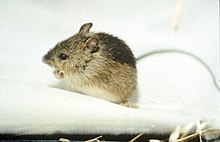Zapodidae
| Zapodidae Temporal range:
| |
|---|---|

| |
Zapus hudsonius preblei
| |
| Scientific classification | |
| Domain: | Eukaryota |
| Kingdom: | Animalia |
| Phylum: | Chordata |
| Class: | Mammalia |
| Order: | Rodentia |
| Superfamily: | Dipodoidea |
| Family: | Zapodidae Coues, 1875 |
| Genera | |
|
| |
| Synonyms | |
|
Zapodinae | |
Zapodidae, the jumping mice, is a family of mouse-like rodents in North America and China.
Although
Jumping mice live in wooded areas, grassy fields and alpine meadows. When disturbed, they can leap eight to ten feet at a time, diminishing to three to four as they widen the gap between them and any pursuer. They are nocturnal and generally live alone. Nests are often found in clefts of rocks, among timber, or in hollow trees. Typically, they will have two to three litters per year.
Taxonomy
Formerly classified in the subfamily Zapodinae alongside the
Classification
There are 11 recent species listed by the American Society of Mammalogists as of 2021.[2]
Family Zapodidae, jumping mice
- Genus Eozapus
- Chinese jumping mouse, Eozapus setchuanus
- Genus Napaeozapus
- Western woodland jumping mouse, Napaeozapus abietorum
- Eastern woodland jumping mouse, Napaeozapus insignis
- Genus Zapus
- Northern meadow jumping mouse, Zapus hudsonius
- Southern meadow jumping mouse, Zapus luteus
- Central Pacific jumping mouse, Zapus montanus
- Oregon jumping mouse, Zapus oregonus
- South Pacific jumping mouse, Zapus pacificus
- Southwestern jumping mouse, Zapus princeps
- Northwestern jumping mouse, Zapus saltator
- North Pacific jumping mouse, Zapus trinotatus
Fossil genera
In addition, four fossil genera are also definitively known:[3][4][5]
- Genus †Javazapus
- Genus †Pliozapus
- Genus †Sinozapus
- Genus †Sminthozapus
See also
- Hopping mouse: a murid rodent native to Australia
- dipodidrodent native to northern Africa and Asia
- heteromyidrodents of North America
- Kultarr: an unrelated marsupial with a similar body plan and coloration; an example of convergence
- pedetidrodent native to southern and eastern Africa
References
- S2CID 86686066.
- ^ Database, Mammal Diversity (2021-08-10), Mammal Diversity Database, retrieved 2021-09-27
- ^ "Mammal Species of the World - Browse: Zapodinae". www.departments.bucknell.edu. Retrieved 2021-10-02.
- ^ "Fossilworks: Zapodidae". fossilworks.org. Retrieved 2021-10-02.
- ^ "Mindat.org". www.mindat.org. Retrieved 2021-10-02.
